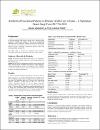Antibiotics Prescription Patterns In Primary Health Care In Qatar A Population Based Study From 2017 To 2018
| Author | Khudadad, Hanan |
| Author | Thalib, Lukman |
| Available date | 2020-10-26T08:49:54Z |
| Publication Date | 2020 |
| Publication Name | Qatar University Annual Research an Exhibition 2020 (quarfe) |
| Citation | Khudadad H., "Thalib, Lukman Antibiotics Prescription Patterns In Primary Health Care In Qatar A Population Based Study From 2017 To 2018", Qatar University Annual Research Forum and Exhibition (QUARFE 2020), Doha, 2020, https://doi.org/10.29117/quarfe.2020.0169 |
| Abstract | Background: Antibiotics are antimicrobial drug used in the treatment and prevention of bacterial infections. They played a pivotal role in achieving major advances in medicine and surgery (1). Yet, due to increased and inappropriate use of antibiotics, antibiotic resistance (AR) has become a growing public health problem. Information on antibiotic prescription patterns are vital in developing a constructive approach to deal with growing antibiotic resistance (2). The study aims to describe the population based antibiotic prescriptions among patients attending primary care centers in Qatar. Methodology: A population based observational study of all medications prescribed in the all Primary Health Care Center during the period of 2017-2018 in Qatar. Records with all medication prescriptions were extracted and linked to medical diagnosis. Antibiotics prescriptions records were compared to non- antibiotics records using logistic regression model in identifying the potential predictors for antibiotic prescriptions. Results: A total of 11,069,439 medication prescriptions over the two-year we found about 12.1% (n= 726,667) antibiotics prescriptions were antibiotics, and 65% of antibiotics are prescribed and received by the patients at the first visits. Paracetamol (22.3%) was the first highest medication prescribed followed by antibiotics (12.1 %) and vitamin D2 (10.2 %). More than half of all antibiotics prescribed during the period of January 2017 to December 2018 were Penicillin (56.9%). We found that half of the antibiotics (49.3 %) been prescribed for the respiratory system comparing to the other body system. We found that male was 29% more likely be given an antibiotic compared to female (OR=1.29, 95% CI= 1.24- 1.33). Implications: The study provides a baseline data to enable PHCC management to design effective intervention program to address the problem of antibiotics resistance. Furthermore, it will help the policymakers to comprehend the size of the issue and develop a system to manage the antibiotics therapy. Conclusions: Antibiotics was the second highest medication prescribed in the Primary Health Care Centers in Qatar after the paracetamol and most of the patients received it at the first visit. Most of the prescriptions in primary health care centers in Qatar were for the respiratory system, and Penicillin was the highest class prescribed. Male visitors were prescribed antibiotics more than female visitors |
| Language | en |
| Publisher | Qatar University Press |
| Subject | Antibiotics antimicrobial resistance Inappropriate Penicillin |
| Type | Poster |
Files in this item
This item appears in the following Collection(s)
-
Theme 2: Population, Health & Wellness [118 items ]


